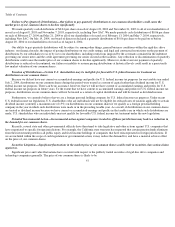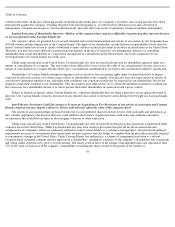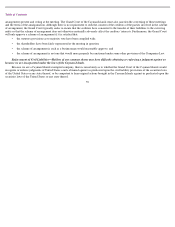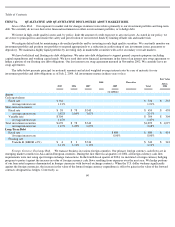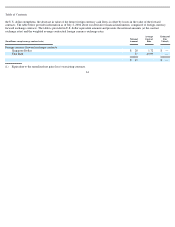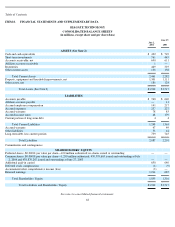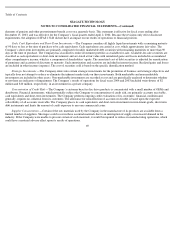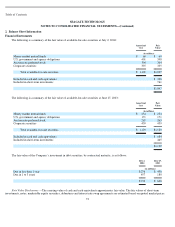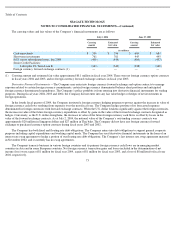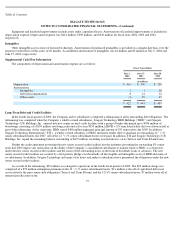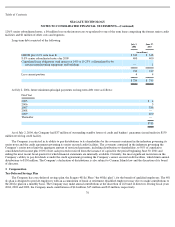Seagate 2003 Annual Report Download - page 68
Download and view the complete annual report
Please find page 68 of the 2003 Seagate annual report below. You can navigate through the pages in the report by either clicking on the pages listed below, or by using the keyword search tool below to find specific information within the annual report.
Table of Contents
SEAGATE TECHNOLOGY
NOTES TO CONSOLIDATED FINANCIAL STATEMENTS—(Continued)
assets are recorded only to the extent the Company concludes it is more likely than not that the assets will be realized.
The Company also has other key accounting policies and accounting estimates relating to uncollectible customer accounts and valuation
of inventory. The Company believes that these other accounting policies and other accounting estimates either do not generally require it to
make estimates and judgments that are as difficult or as subjective, or it is less likely that they would have a material impact on its reported
results of operations for a given period.
Basis of Consolidation —The consolidated financial statements include the accounts of the Company and all its wholly-owned
subsidiaries, after eliminations of intercompany transactions and balances.
The Company operates and reports financial results on a fiscal year of 52 or 53 weeks ending on the Friday closest to June 30.
Accordingly, fiscal year 2004 comprised 53 weeks and ended on July 2, 2004. Fiscal years 2003 and 2002 each comprised 52 weeks and ended
on June 27, 2003 and June 28, 2002, respectively. All references to years in these notes to consolidated financial statements represent fiscal
years unless otherwise noted. Fiscal year 2005 will be 52 weeks and will end on July 1, 2005.
Foreign Currency Remeasurement and Translation —The U.S. dollar is the functional currency for the Company’s foreign operations.
Gains and losses on the remeasurement into U.S. dollars of amounts denominated in foreign currencies are included in net income (loss) for
those operations whose functional currency is the U.S. dollar and translation adjustments are included in other comprehensive income (loss)
and as accumulated other comprehensive income (loss), a separate component of shareholders’ equity, for those operations whose functional
currency is the local currency.
Derivative Financial Instruments —The Company applies the requirements of Statement of Financial Accounting Standards (“SFAS”)
No. 133,
“Accounting for Derivative Instruments and Hedging Activities” (“SFAS 133”) and SFAS No. 149, “Amendment of Statement 133
on Derivative Instruments and Hedging Activities,” (“SFAS 149”). Both standards require that all derivatives be recorded on the balance sheet
at fair value and establishes criteria for designation and effectiveness of hedging relationships.
Revenue Recognition, Sales Returns and Allowances, and Sales Incentive Programs —The Company’s revenue recognition policy
complies with Staff Accounting Bulletin No. 101/104, “Revenue Recognition in Financial Statements.” Revenue from sales of products,
including sales to distribution customers, is recognized when title and risk of loss has passed to the buyer, which generally occurs upon
shipment from the Company or third party warehouse facilities, persuasive evidence of an arrangement exists, including a fixed price to the
buyer, and when collectibility is reasonably assured. Estimated product returns are provided in accordance with SFAS No. 48, “Revenue
Recognition When Right of Return Exists.” The Company also adheres to the requirements of EITF 01-09 “Accounting for Consideration
Given by a Vendor to a Customer,” (“EITF 01-09”) for sales incentive programs. The Company follows FTP 90-1 “Accounting for Separately
Priced Extended Warranty and Product Maintenance contracts” for sales of extended warranties.
In the third quarter of fiscal year 2002, the Company’s North American distribution customers transitioned from a consignment model,
under which the Company recognized revenue when distributors sold the Company’s products to their customers, to a sell-in model, under
which the Company recognizes revenue when its products are sold to distributors. During fiscal year 2002, this transition resulted in a one-
time
increase in total revenue, operating income and net income of approximately 1%, 3% and 7%, respectively.
67


